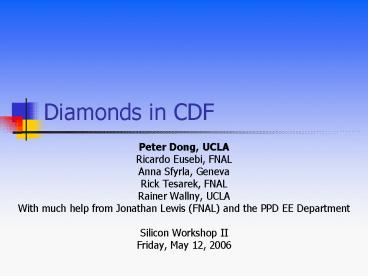Diamonds in CDF - PowerPoint PPT Presentation
Title:
Diamonds in CDF
Description:
We need to monitor the radiation field so we can pull an abort if the beam ... read out at ~8Hz by a Keithley electrometer over ~100 feet of cable on the first ... – PowerPoint PPT presentation
Number of Views:109
Avg rating:3.0/5.0
Title: Diamonds in CDF
1
Diamonds in CDF
- Peter Dong, UCLA
- Ricardo Eusebi, FNAL
- Anna Sfyrla, Geneva
- Rick Tesarek, FNAL
- Rainer Wallny, UCLA
- With much help from Jonathan Lewis (FNAL) and the
PPD EE Department - Silicon Workshop II
- Friday, May 12, 2006
2
Why do we want diamonds?
- Beam incidents can damage the silicon.
- We need to monitor the radiation field so we can
pull an abort if the beam becomes unstable. - Our present radiation monitoring has drawbacks
- Loss counters far from the silicon
- BLMs slow response with current electronics
- PIN diodes passive monitors (cannot be used for
an abort)
3
Properties of diamond
Silicon Diamond
Band gap eV 1.12 5.45
Electron mobility cm2/Vs 1450 2200
Hole mobility cm2/Vs 500 1600
Saturation velocity cm/s 0.8x107 2x107
Breakdown field V/m 3x105 2.2x107
Resistivity O cm 2x105 gt1013
Dielectric constant 11.9 5.7
Displacement energy eV 13-20 43
e-h creation energy eV 3.6 13
Average e-h pairs per MIP per µm 89 36
Charge coll. dist. µm full 250
Low Ileakage, shot noise
Fast signal collection
Low capacitance, noise
High radiation hardness
Smaller signals
4
Why we want diamonds
- In short, diamonds are
- Small they can fit almost anywhere
- Fast their response time is very short
- Hard they will remain essentially unaffected by
radiation at the Tevatron. - This means they can sit very close to the
silicon, never have to worry about radiation
damage, and can pull an abort very quickly. - BaBar and Belle already have diamond systems CMS
and ATLAS will install them as well. CDF is the
first hadron collider detector to use diamonds.
5
Our first diamond
- In August 2004 we installed a diamond in the east
plug. - It was read out at 8Hz by a Keithley
electrometer over 100 feet of cable on the first
floor in B0. - After irradiation, we saw a leakage current of
200 pA (from 1 pA). - Signal during normal store 1 nA.
6
Typical Shot Setup
scraping
9 pbar transfers
Final proton injection (36 bunches)
collisions
ramping
7
Readout Electronics
- Use readout system for Tevatron BLM electronics
upgrade - Installed this shutdown
- Digitizer
- 4 channels with integrator and ADC
- Generates primary abort signals
- Runs at 20 ms slower than intrinsic signal
formation time of diamond, but its the best we
can do for now - Timing Card
- Synchronizes digitizers
- Latches control signals
- Abort Concentrator
- Controls masking and multiplicity of inputs from
digitizer - Controller
- Interface to VME for crates with abort
- High Voltage
- Up to 2.25 kV use voltage divider to get 500V
(and prevent accidental application of too much
voltage) - Front-End CPU
- MVME 2xxx Acnet interface, etc.
Digitizer card
HV card (4 channels)
FE CPU
Timing Card
Electronics designed by Accelerator Division EE
department
8
Our Diamonds
In November 2005, while the Tevatron was shut
down for repairs, we installed three more
diamonds in CDF and one in the Tevatron. These
diamonds have since been removed.
West low-beta quad
West BLMs
E1, just downstream of E0 collimator
9
What can we see?
Quench at B0
Collimator move during scraping
Diamonds
BLM
10
The full diamond system
- Installed four diamonds on each side of the
tracking volume. - Mounted on a plastic support structure that
clamps onto the beampipe, putting diamonds at a
radius of 2 cm. - Connected to triaxial cables (colored yellow for
easy identification) that penetrate the silicon
baggie and the foam. - Read out in a crate on the first floor.
11
The new diamonds
West side
East side
The installation crew
12
The next step
- Weve installed all the diamonds, tested them
with a source, and checked all the cables from
the first floor. - Need to install the crate, get the hardware and
software working. - When the beam turns on, then the real testing
begins. - Once the behavior of the diamonds is understood,
we can look at implementing abort functionality.
13
Conclusion
- Our diamond detectors are real-time radiation
monitors in the tracking volume. - We now have eight diamonds installed in CDF, and
are in the process of commissioning them. - These should allow faster response to beam
incidents and better protection of the silicon.































